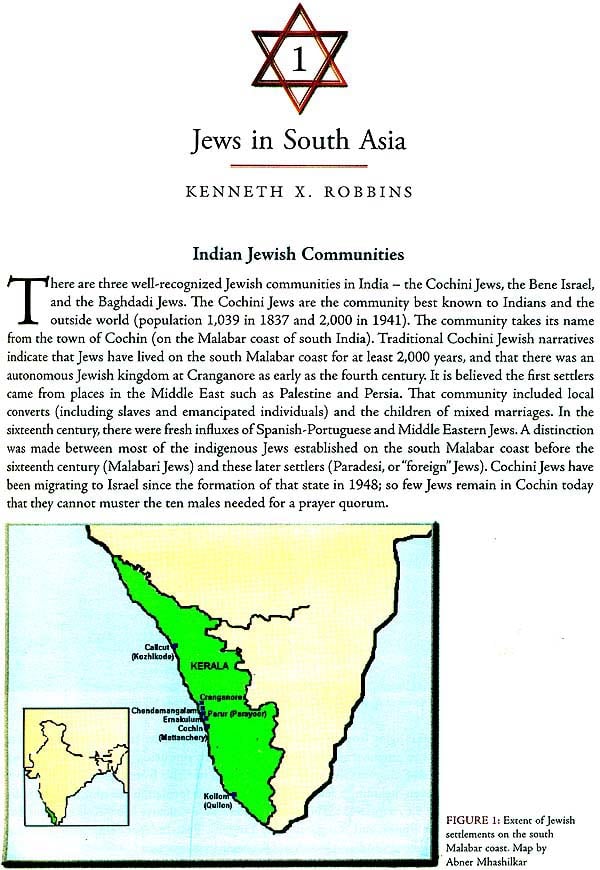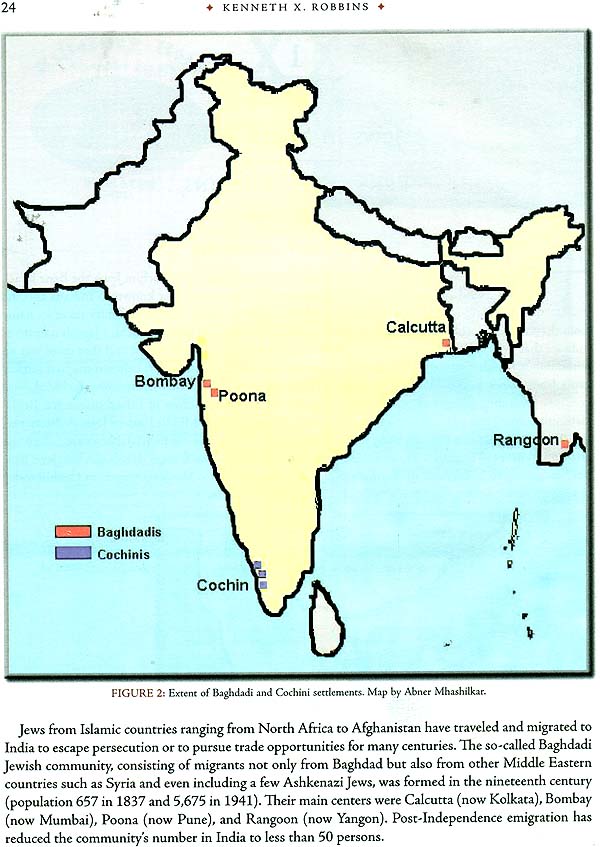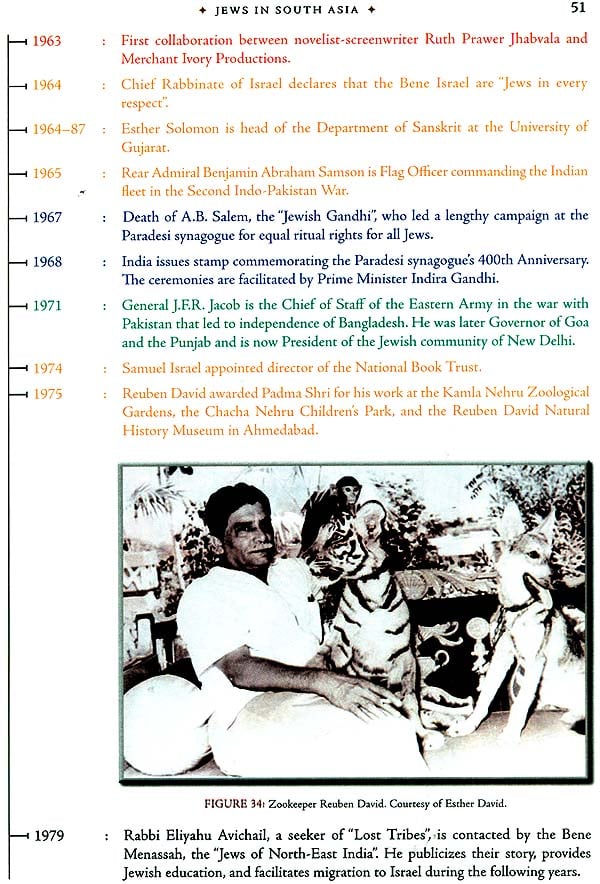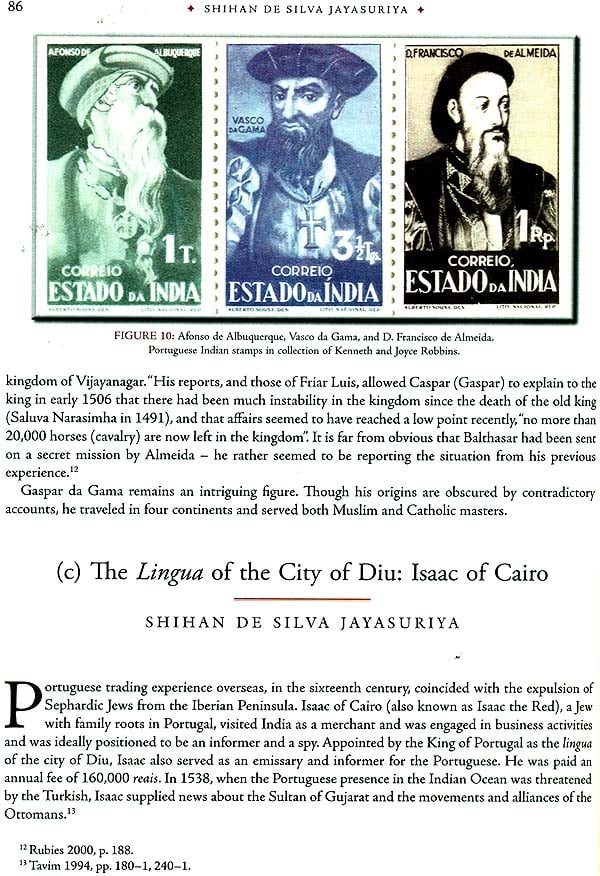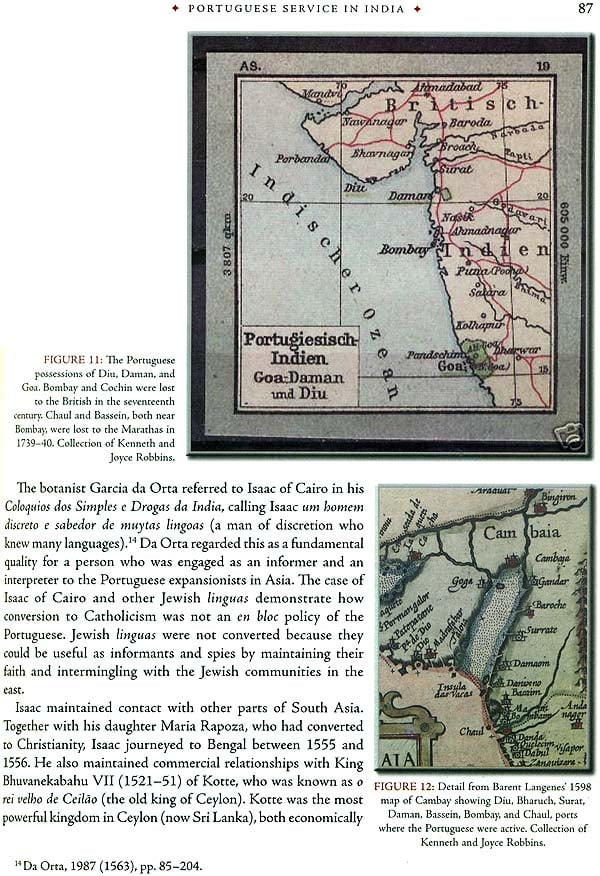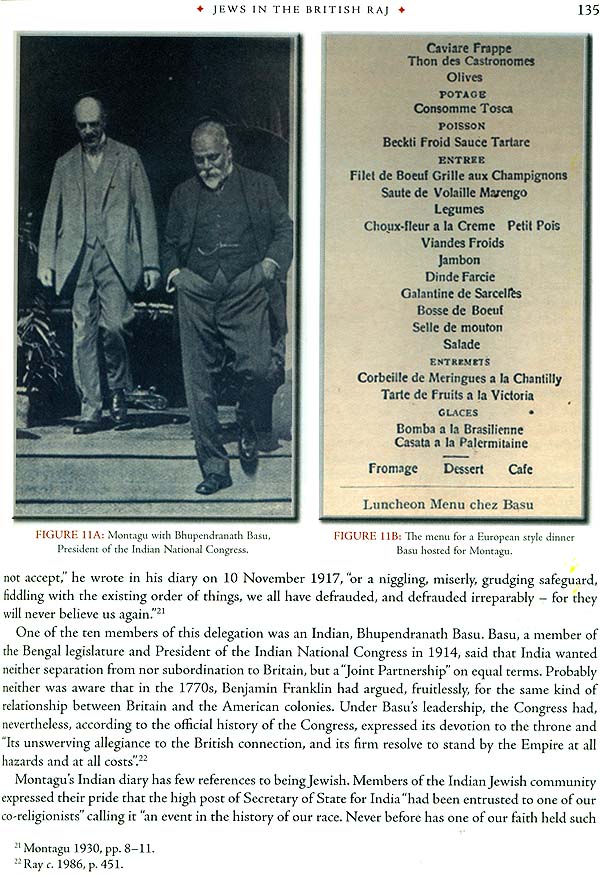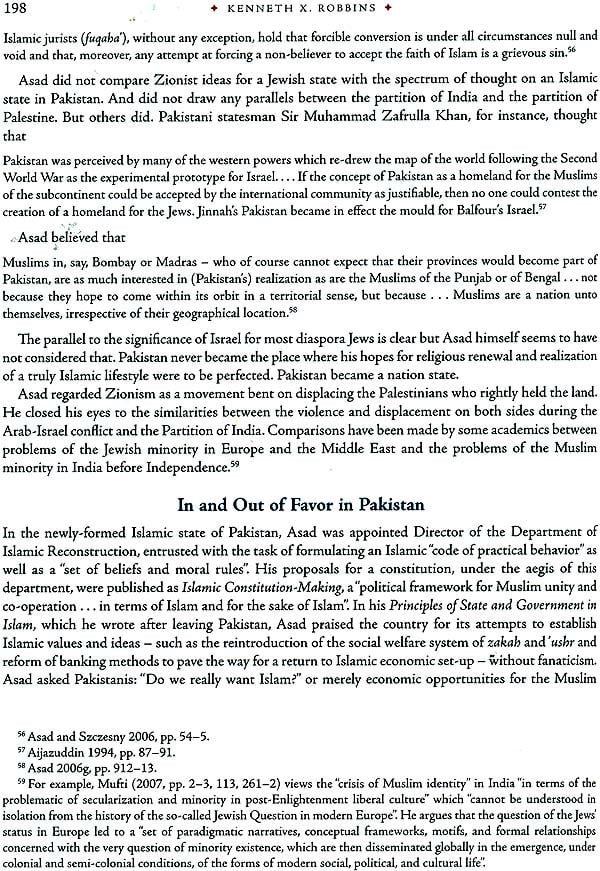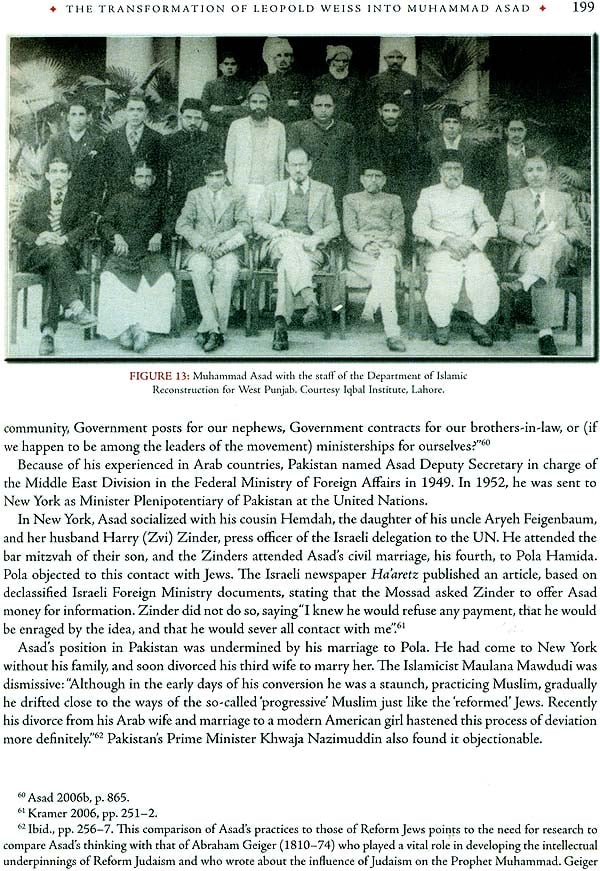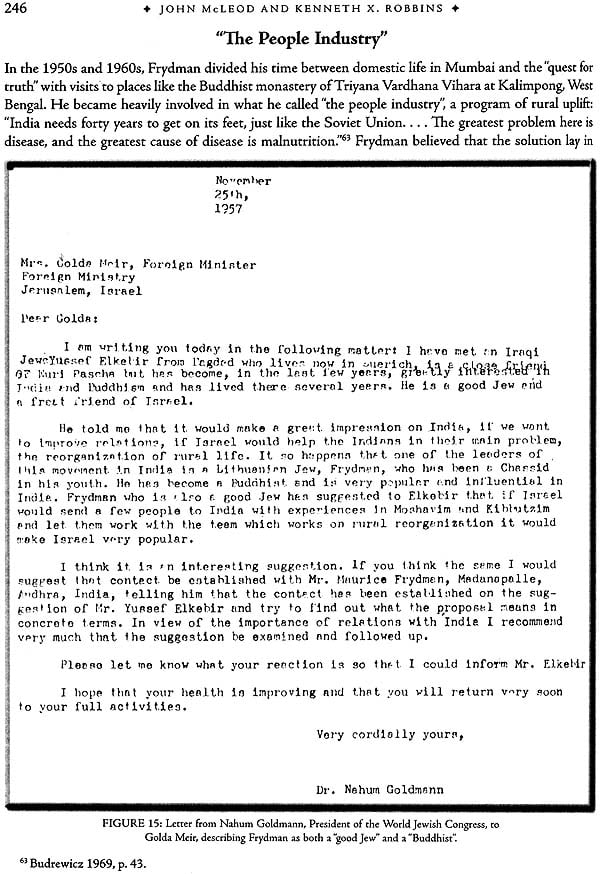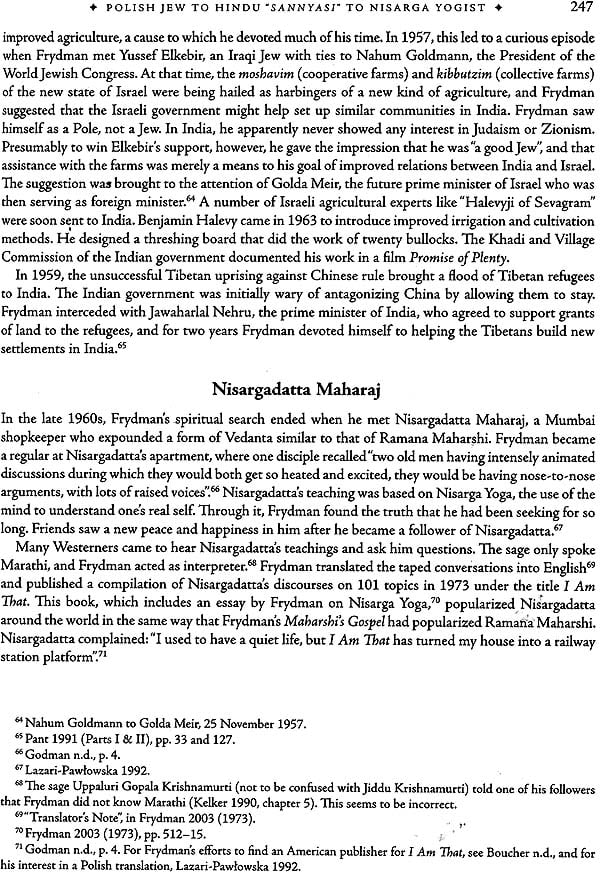
Western Jews in India (From the Fifteenth Century to the Present)
Book Specification
| Item Code: | NAM184 |
| Author: | Kenneth X. Robbins and Marvin Tokayer |
| Publisher: | Manohar Publishers and Distributors |
| Language: | English |
| Edition: | 2013 |
| ISBN: | 9788173049835 |
| Pages: | 310 (Throughout Color and B/W Illustrations) |
| Cover: | Hardcover |
| Other Details | 11.5 inch x 8.5 inch |
| Weight | 1.30 kg |
Book Description
This is the book describing the roles of Western Jews in South Asian political affairs, medicine, painting, architecture and religion. A time-line summarizes their contributions and those of the Indian Jews to the Indian subcontinent. Many of these foreign Jews left behind their Jewish identities. Others remained Jews, but functioned as individuals unconcerned with implementing any ‘Jewish agenda’.
The Mother, a great mystic and leader of the Aurobindo ashram, was a French artist with a Turkish Jewish background. Maurice Frydman (Bharatananda), an important associate of Nisargadatta Maharaj and other gurus, tried to create a Gandhian democracy in Aundh. Muhammad Asad (Leopold Weiss) was an important Islamic political thinker and government official in Pakistan. Jews provided the Portuguese, who persecuted them, with language skills and access to trading networks. Jean- Baptiste Ventura became commander of the Sikh armies. In1921, Lord Reading and Edwin Montagu were the two highest British officials governing India.
Garcia da Orta was a founder of tropical medical botany in the sixteenth century. Waldemar Haffkine, who created anti-cholera and plague vaccines, undertook large-scale vaccination programmes in India. Louis Kahn created the iconic National Parliament House in Bangladesh. The buildings of Moshe Safdie, Joseph A. Stein, and Stanley Tigerman are very well known in India and Bangladesh.
The editors Kenneth X. Robbins and
Rabbi Marvin Tokayer commissioned original articles from eminent historians (Guy Attewell, Ainslie T. Embree, Shihan de Silva Jayasuriya, Omar Khalidi, John McLeod, Marina Sorokina), architects (Moshe Safdie, Stanley Tigerman, and Terry Horowitz), members of Indian royal families (Arvind Singh Mewar, Kocha Varma) and the most famous living Indian Jew (Lt. General J.F.R. Jacob) for this volume. The articles are combined with a very large number of illustrations ranging from paintings, photographs, maps, medals, stamps, and documents to photographic essays on painters and architects.
Kenneth X. Robbins is a psychiatrist, collector, and independent scholar on South Asia. His major areas of interest are the Maharajas and other Indian princes, as well as Rajputs, African Muslim elites, Sikhs, and Jews.
Marvin Tokayer was rabbi for the Jewish Community of Japan and vice-president of the Federation of Jewish Communities of Southeast Asia and the Far East. He has authored more than 20 Japanese books on Judaica. He has participated in the Jewish dialogue with 'Eastern Religious Leaders' as well as visiting and helping Indian and Chinese Jews.
Over the centuries, my ancestors in the Ruling Family of Cochin accorded to Jews a status unheard of elsewhere. The Rajas befriended, protected, and favored Jews and encouraged them to settle in Cochin and openly practice their religion. The story of Cochin shows how Jews from North Africa, Asia, and Europe were accepted and could flourish in the diaspora as a community without losing their identity as Jews.
Rama Varma, the last reigning Maharaja, addressing his Jewish subjects at the Paradesi synagogue in 1949, said :
I am deeply touched by the spontaneous expressions of love and loyalty to my family and myself....Cochin and its people owe much to you. The memory of your early association with this country has always been pleasant....The people of Cochin received you with open arms; the Ruling Family protected you from plunder and persecution....My grandmother used to tell us of the very pleasant hours she and the other princesses of her age spent in the company of your women-folk who usually gathered in the Palace in the afternoon. This famous temple....is also a standing monument of the religious tolerance and hospitality that prevailed in this part of the country from time immemorial ... (and) a clear and visible evidence of the material prosperity and progress attained by your community under the kind patronage of the Royal family ever since you came here as the honored guests of the people....No other people deserved such treatment better.
In 2005, the Jewish organization Bnai Brith sent a delegation to present a humanitarian award to the current members of the Cochin Royal Family in honor of their ancestors who had shown such rare magnanimity in welcoming Jewish settlers.
The accomplishments of Jews in South Asia were not limited to Cochin, nor were they restricted to communities that settled in India. Many individual Western Jews who came to the subcontinent contributed significantly to the political, religious, artistic, and architectural heritage of India. Jewish architects built famous buildings in Ahmedabad, Anandpur Sahib, Dhaka, Karachi, Kashmir, and New Delhi. Jewish doctors made major contributions to the public health of Indians. European Jews also played major roles in shaping contemporary Indian art. I am excited about this potentially trailblazing book that brings together, for the first time, the stories of such Jews in the subcontinent.
The Cochini, Bene Israel, and Baghdadi Jewish communities of India flourished and prospered in India as fully accepted, productive members of society with special accomplishments in military, medicine, literature, business, charitable work, and the film industry. Now we have a highly illustrated and well, researched groundbreaking book dealing with the contributions of individual European and American Jews to the Indian subcontinent.
I am a military man myself part of the proud military traditions of Indian Jews. The Bene Israel have been long known for their service in the forces of the Marathas, Janjira, the British, and independent India. Now we can add to this illustrious history the story of an Italian Jew, General Ventura. Ventura was a leading figure in the kingdom of Lahore. Like me, he was both a general and a governor.
I have vivid memories of meeting The Mother, one of the eminent figures of Jewish origin featuring in this book, who is still widely revered in India today. When she blessed me for my role in the 1971 war for the liberation of Bangladesh by placing her hand on my head, I could sense the vibrations passing right down my body.
There has never been any anti-Semitism in India except by the Portuguese colonists. When I was in Goa, as governor, I was saddened to learn that the Inquisition exhumed and burned the bones of the great naturalist Garcia da Orta, as well as burned his books. Jews will always be thankful to India for providing a haven from endemic virulent anti-Semitism. Indian Jews have both been Indians and Jews. There was never a conflict.
The publication of this book will make other Indians, and indeed the world, aware of how much Jews, including foreign Jews, have done for India.
More than 40 years ago, I saw a seventeenth, century Indian miniature painting in a Madison Avenue art dealer's window. A fascination with India immediately developed, which somehow led to this book about European and American Jews in South Asia. That miniature painting spurred me to begin collecting Indian paintings, and before long, my collection included everything from medals and picture postcards to documents and books relating to the political, cultural, and religious history of the Maharajas and other regional Indian rulers. While documenting the histories of Indian dynasties, I keep finding information about the roles of Indian Jewish communities and individual foreign Jews in the history of South Asia.
When I edited a book on Africans in India, I realized that many of the Bene Israel, India's largest indigenous Jewish community, once resided in the domains of the African Muslim Nawabs of Janjira. Distinguished families like the Wargharkars, Divekars, Dandekars, and Rajpurkars later migrated all over South Asia. Their number included many military heroes, a mayor of Bombay, and prime ministers of three Princely States as well as an eminent zookeeper and his famous novelist daughter.
Jews with European roots have been coming to South Asia for centuries. Spanish Jews based in North Africa were involved in the India trade a thousand years ago; a Polish Jew greeted Vasco da Gama when he landed in India in 1498. Western Jews were often welcomed as experts in military affairs, medicine, art, or architecture, European Jews were closely associated with indigenous rulers of Lahore, Cochin, Sardhana, Aundh, Baroda, and elsewhere, Farasu flourished as a poet at the court of Begum Samru; Maurice Frydman tried, with the Raja’s help, to create a democracy on Gandhian principles in Aundh. According to a museum label, the original name of the “French General” Ventura (1794-1858), who commanded the armies of the Sikh Maharaja Ranjit Singh, was Reuben Ben Torah. He turned out to be an Italian Jew.
South Asia is the only place in the world where past centuries of Jewish life were not shaped and defined by anti-Semitism. There was one exception: Only the Portuguese systematically represented the Jews, Nevertheless, Jews such as Isaac the Red and New Christians like Gaspar da Gama provided invaluable service with their language skills and their contacts in trading networks. Some New Christians (many forcibly converted by the Portuguese) fought to retain their old religion. In Cochin, New Christians were in close commercial and personal association with practicing Jews in the territories of the Rajas during the sixteenth century until the Inquisition did its work. However, networks involving Jews and New Christians continued in both intra-European and intercontinental trade in the seventeenth century.
Many persons with Western Jewish roots even made contributions to Pakistani society, a country where anti-Semitism is endemic and there is no longer a local Jewish community. For example, Pakistan recently issued a stamp in honor of one of its most honoured and gifted and gifted artists Anna Molka Ahmed, who was born into a Jewish family in Britain. According to a recent article published there, painter Anna Molka Ahmed “resolved (the) stream of interfaith”. Two of Pakistan’s most important and controversial Islamic thinkers, Mohammad Asad and Maryam Jemeelah, were born into Western Jewish families. The Pakistanis recruited European Jewish doctors to serve in their army just after Independence, and a Holocaust refugee was one of the leading physicians in Lahore until 1971. The Bene Israel dancer-movie actress Azurie migrated to Pakistan with her Muslim husband. Several of the most important early twentieth-century building in Karachi were built by a Baghdadi Jew, Moses Somake. Western Jewish architects built the iconic National Parliament House and other important buildings in what is now Bangladesh. Luis Kahn’s plans to build a great synagogue in Jerusalem did not deter Pakistani or Bangladeshi officials from working with him. Moshe Safdie’s reputation as a builder of Jewish projects was a major factor in his selection as the architect of the Sikh Heritage Complex in India, but he was later asked to design buildings for the Asian University for Women in Chittagong. Mark Siegel, the producer of a documentary on Benazir Bhutto, was her close and a lobbyist for Pakistan.
Some Jews played important roles in British India. Three Spanish-Portuguese Jewish merchants were aldermen with Governor Yale in Madras in 1688. Bacteriologist Waldemar Haffkine, founder of Mumbai’s famous Haffkine Institute, saved many Indian lives by vaccinating Indians against cholera and plague. In 1921, two Jews, Lord Reading and Sir Edwin Montagu, were the top officials in- charge of British India. Sir Lionel Abrahams was under-secretary of state, when he died in 1919. Sir Cecil Kisch (1884-1961), who was private secretary to Montagu, played an important role in Indian. His father Hermann Michael Kisch (1850-1942) had been a deputy secretary to the Indian government and postmaster of Bengal. Many in Great Britain looked upon European Jews like Montagu Reading as “Orientals” and therefore more sympathetic to Indian aspirations.
| Foreword | ||
| Kocha Varma | 9 | |
| (a) | Lt. General J.F.R. Jacob | 11 |
| (b) | Introduction: Western Jews on the subcontinent Kenneth x. Robbins | |
| 1 | Jews in South Asia | 13 |
| 2 | European Jews in the Miltary Service and Courts of Indian Rulers | |
| (a) | Jean-Baptiste Ventura (1794-1858): The Italian Jew Who Become the "French" Commander-in Chief of the Sikh Army | 55 |
| (b) | Farasu (1777-1861): Poet, Government Official, Soldier at the Court of Begum Samru | 74 |
| 3 | Portuguese Service in India | |
| (a) | Jews and New Christians in Portuguese Service in India | 79 |
| (b) | The Polish Jew who Became a Portuguese Lingua: Gaspar da Gama | 81 |
| (c) | The Lingua of the City of Diu: Isaac of Cairo | 86 |
| 4 | Jews, New Christians, and the Portuguese on the South Malabar Coast | 91 |
| 5 | Subversion in a Liminal Space: Perso-Arab Learning, Asian Medicinals and the European Classical Revival in the Coloquios (1563) of Garcia da Orta Guy Attewell | |
| 6 | Jews in the British Raj: Sir Edwin S. Montagu (1917-1922) and Lord Reading (1921-1926) | |
| (a) | "You Have Cut My Bonds and set Me Free-Now Let Me Help You Set Others Free" | 125 |
| (b) | Edwin Samuel Montagu | 130 |
| (c) | Rufus Isaacs, 1st Marquess of Reading | 142 |
| (d) | Lord Reading's First Year as Viceroy (As Seen by an Indian Jew) | 156 |
| 7 | Between Faith and Reason: Waldemar Haffkine (1860-1930) in India | 161 |
| 8 | The Transformation of Leopold Weiss into Muhammad Assd (1900-1992) | 179 |
| 9 | From French Jew to Indian Goddess: The Story of Mirra Alfassa, the Mother (1878 -1973) | 207 |
| 10 | pPolish Jew to Hindu "Sannyasi" to Nisarga Yogist: Maurice Frydman (Bharatananda) C. 1901-1976) | 229 |
| 11 | Artists and Architects | |
| (i) | Western Jewish Women Artists | |
| (a) | Western Jewish Women Artists in South Asia | |
| (b) | Martha Isaacs: A Portraitist and Miniaturist in Calcutta c. 1778- 1822 | 251 |
| (c) | Anna Molka Ahmed (1917-1994): Pakistani "National" Artist | 254 |
| (ii) | Western Jewish Architects | |
| (a) | Jewish Architects in India, Pakistan, and Bangladesh | 264 |
| (b) | The "Natural" Architecture of Joseph Allen Stein (1912-2001) | 266 |
| (c) | Moshe Safdie (b. 1938) and the Khalsa Heritage Complex | |
| 1 | Jewish Architect, Sikh Museum | 270 |
| 2 | The Khalsa Memorial Complex at Anandpur Sahib, the Punjab | 272 |
| (d) | Monumental Magnificence: Louis I. Kahn in India and Bangladesh | 278 |
| (e) | Working with MuzharulIslam in Bangladesh | 288 |
| (f) | The Architect Sidney Epstein and the gHouse of Mewar | |
| 1 | Sidney Epstein | 291 |
| 2 | My Personal Relationship with Sidney Epstein | 293 |
| List of Contributors | 297 | |
| Acknowledgments | 299 | |
| Bibliography | 301 |
